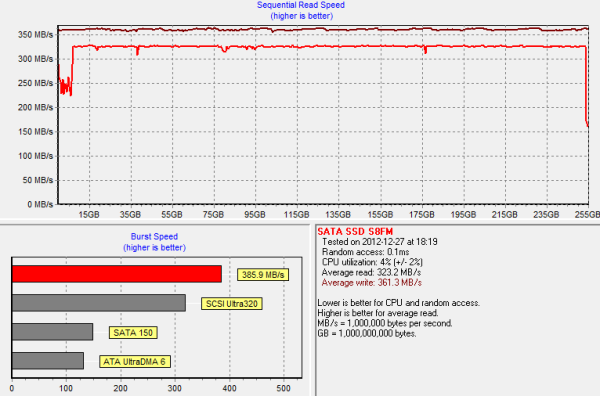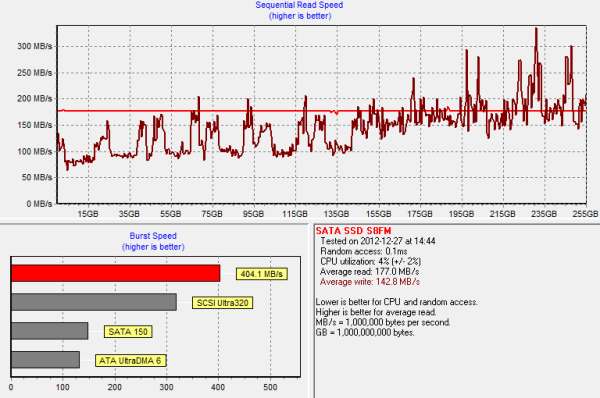MyDigitalSSD SMART & BP3 mSATA SSD Review
by Kristian Vättö on January 22, 2013 1:24 PM ESTPerformance Over Time & TRIM
As the SMART is a SandForce drive with the stock firmware, I decided not to test its TRIM performance because we have tested that so many times, the latest being our article on SandForce TRIM issue. Hence this part will only cover the BP3 but since it's a new, untested controller, this data should be rather interesting. Let's start with HD Tach ran on a secure erased drive:
For our torture test, I filled the drive with sequential data and hammered it with 4KB random writes (100% LBA space, QD=32) for 40 minutes:
Performance is actually fairly good. The worst drop is around 70MB/s right at the beginning but after about half of the LBAs have been written with sequential data, the average data rate is around 200MB/s. Part of the cause for this is the fact that the BP3 has slow random write performance, which means it will write less data to the drive than what faster drives would, resulting in a less fragmented drive.
Next I secure erased the drive, filled it and tortured it again and TRIM'ed after torture:
TRIM performance is rather dubious. Performance is definitely better than without TRIM but it's still far from clean state performance. I have a feeling that the controller itself is not very powerful so it may simply not be able to do garbage collection on all the blocks without some idle time between torture and HD Tach run (I immediately TRIM'ed the drive after torture and began the HD Tach run). It would explain why the performance is over 300MB/s for a large part of the drive. The controller may have cleaned some of the blocks and the first writes go there but in the end it faces a situation where it has to read-modify-write because all blocks are full, and write performance drop to figures similar to after torture test.













49 Comments
View All Comments
philipma1957 - Tuesday, January 22, 2013 - link
The crucial mSata 256gb is pretty good for asrock z77-itx board and for intels h77 itx board.They allow for a small desktop. I would like the 3 mobos I used to allow sata III they only allow Sata II.
philipma1957 - Tuesday, January 22, 2013 - link
Follow upI have these mobos
ASRock Z77E-ITX LGA 1155 Intel Z77 HDMI SATA 6Gb/s USB 3.0 Mini ITX Intel Motherboard
Intel BOXDH77DF LGA 1155 Intel H77 HDMI SATA 6Gb/s USB 3.0 Mini ITX Intel Motherboard
ASUS Maximus V Gene LGA 1155 Intel Z77 HDMI SATA 6Gb/s USB 3.0 Micro ATX Intel Motherboard
all are running with just the crucial msata 256gb ssds .
I would not mind one with a Sata III slot , I do agree msata is not offered as viable option for the system builder.
Death666Angel - Tuesday, January 22, 2013 - link
All I could find is that mSATA is only specified for SATA 1.5Gb/s and SATA 3 Gb/s, not SATA 6 Gb/s.nathanddrews - Tuesday, January 22, 2013 - link
Forgive me if I missed it, but should there be a benchmark showing performance consistency when factoring 25% spare area? Given AT's recent affinity for such benchmarks, I now expect to see it in every SSD review./rabble rabble!
Kristian Vättö - Tuesday, January 22, 2013 - link
It's not something we test with every drive because for example all SandForce drives behave the same way. I've actually had these drives for nearly six months and tested them long ago but the write up was pushed back by more urgent reviews. I know I may sound lazy here, but I don't consider the BP3 or SMART to be the choice for many already given the fact that mSATA isn't very popular and I see the majority of buyers going with name brands, so I decided not to test performance consistency this time.The random write speed is rather slow to begin with, and it gets below 1MB/s when tortured.
fugu_ - Tuesday, January 22, 2013 - link
It would have been nice to see performance consistency benchmarks for the drive that used the Phison controller, especially since there are only a handful of options for ~250GB mSATA drives.It's great to see any sort of reviews of lesser known drives. At the same time, it's a little disappointing that the perceived popularity of these drives stopped you from doing a more complete review, especially if you've had them for 6 months.
Kristian Vättö - Tuesday, January 22, 2013 - link
Yeah, I know it's not a proper excuse. This spring will be quite busy for me though, have plenty of SSDs to review and at the same time I should study for matriculation exams as well as university entrance exams.I know I shouldn't be making excuses, but I hope you can relate to my situation. I try to cut as few corners as possible but performance consistency is just PITA to test (well, the actual testing is fine but making the graphs is just painful because Microsoft can't make Office that's fully compatible with Office for Mac... Anand does the graphs on Mac, so I have to do too or they won't be identical). After that it's time for awful HTML editing which I suck at, so that takes way more time than it should.
Per Hansson - Wednesday, January 23, 2013 - link
Well if this is the place where we ask you to do performance consistency tests before your exams I'm in :)I would just love to see how the most crappy SSD controller of all; the JMicron JMF602 fares in performance consistency.
I think it would be a nice thing to look back at with what we know today.
Shockingly SSD's based on such controllers are still being sold!
http://www.prisjakt.nu/kategori.php?k=893#rparams=...
lyeoh - Wednesday, January 23, 2013 - link
Yeah I'd like to see the performance consistency for the lower end or even crap SSDs.Maybe even a few conventional spinning platter hard drives- low, mid, high.
Kristian Vättö - Wednesday, January 23, 2013 - link
Unfortunately, I don't have any SSDs that old. The "worst" SSDs I have are Crucial v4, OCZ Agility 4 and Samsung SSD 470. I could definitely run something on the V4 and BP3 to see if Phison has done any progress in this matter.